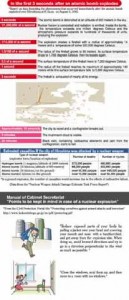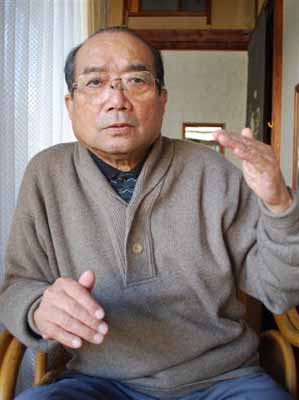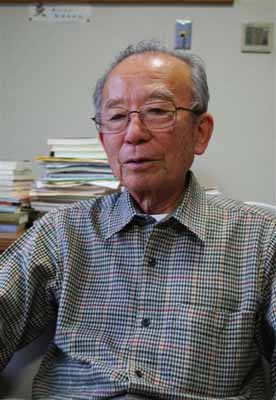”Absurd” guidelines for surviving a nuclear attack
Apr. 16, 2008
by Miho Kuwajima, Staff Writer
“Don't look at the flash or fireball resulting from a nuclear explosion, as you may lose your eyesight.” “Hide behind a shielding object at once. If there are buildings, take refuge in one of them. Underground facilities and concrete buildings are safer.”
These guidelines are part of the Civil Protection Portal Site launched by the Cabinet Secretariat for “measures to survive nuclear attacks.” Accompanying these instructions is an illustration of a man seeking protection from an attack by covering his head with a jacket and his mouth with a handkerchief. But how did Japan, which should be fully aware of the consequences of an atomic bombing, come to use guidelines of this sort as the basis for its security? With the city of Hiroshima issuing its own Civil Protection Plan at the end of March, the Hiroshima Peace Media Center explored the background of this circumstance.
In the United States, the Federal Emergency Management Agency (FEMA) is partly responsible for civil defense, relief efforts, and other functions in the event of a disaster. A search of its website, using “nuclear blast,” leads to a section of guidelines involving actions to be taken in such a scenario.
In this section can be found the instruction “Do not look at the flash or fireball--it can blind you.” Apparently, since the language used by FEMA and the Japanese government is nearly identical, the Cabinet Secretariat referred to the site when they were devising their own evacuation guidelines for the Civil Protection Portal Site.
However, neither website makes mention of the fact that a bomb's thermal rays will char the human body or that a nuclear blast will devastate a city in an instant. Moreover, there is no reference to the suffering of hibakusha from the effects of radiation exposure, which will last for decades afterward.
Asked the reason, a Japanese government official responsible for the project stated tersely that “This plan is not intended for people near the hypocenter. These are evacuation guidelines for people in outlying areas and provide protection from the secondary effects of the blast, such as radioactive fallout.”
Under the Bush administration's doctrine of “pre-emptive strike,” triggered by the terrorist attacks of September 11, 2001, the government of former Prime Minister Junichiro Koizumi enacted a series of measures to contend with military emergencies. As part of this legislation, the Civil Protection Law was passed in June 2004. This law has obligated municipal governments nationwide to draw up “civil protection plans” which specify the evacuation procedures of their residents in the event of a military emergency, including armed attack or terrorism.
A nuclear weapons attack is included, too, since “It cannot be ruled out that a nuclear attack will never again occur in Japan.” If a third nuclear bomb should be dropped over Japan, municipal governments are responsible for providing residents with evacuation and relief measures as well as making efforts to minimize the damage from such an attack.
Based on this scenario of nuclear attack, the “model guidelines” displayed at the Civil Protection Portal Site are meant “to inform the public of evacuation measures in a form that can be easily understood,” as one official from the Cabinet Secretariat put it.
Dr. Hiroko Takahashi, 39, a research associate of the Hiroshima Peace Institute at Hiroshima City University, points out that “The civil protection plan, which disregards the experiences of Hiroshima and Nagasaki, categorically ignores the effects of radiation. This stance is exactly the same as the U.S. civil defense program in underestimating A-bomb damage.” Dr. Takahashi believes the guidelines from FEMA, which the Japanese government drew from, were “conceived for the Cold War era as an instrument to wield fear against the Soviet Union and justify the nuclear arms race.”
Dr. Hiromi Hasai, 76, an A-bomb survivor and nuclear physicist who lives in Hiroshima, argues against the “model guidelines” devised by the central government. “Should a nuclear weapon explode, the damage is already determined in the first three seconds. There is nothing any public administration can do to counteract that.”
In his capacity as chairman of “The Nuclear Weapons Attack Damage Estimate Task Force,” set up by the city of Hiroshima for the purpose of preparing its civil protection plan, Dr. Hasai investigated the question: “What would happen if a nuclear weapon were dropped over the city right now?” Dr. Hasai and the other members of his committee, including medical doctors, spent a year compiling a 150-page report that estimates the likely damage.
The report indicates that in the event of a one-megaton hydrogen bomb explosion near the A-bomb Dome in downtown Hiroshima, “Conservatively, 372,000 people would die in the blast and the number of injured would be 460,000.” The report concludes that “The abolition of nuclear weapons is the only means toward true ‘civil protection'.”
“It's absurd how our own central government views nuclear weapons so lightly.” Hirotami Yamada, 76, Secretary General of the Nagasaki Council of A-bomb Survivors, continued, “I was incensed when I saw those illustrations--they're like cartoons.”
At the time of the bombing of Nagasaki, Mr. Yamada's house was located roughly 900 meters from the hypocenter. Although his mother, older sister, younger brother, and baby brother were at home, all of them apparently survived the bombing unharmed. Three days later, however, the baby passed away and the following morning his older sister also died. Shortly after, in late August, his mother and younger brother died, too, blood running from their gums. His father, who had been working at a location 1.3 kilometers from the hypocenter, died of lung cancer 16 years later.
“If another bomb is dropped, it will spell the end,” says Mr. Yamada. “We must persist with our appeal for peace from ‘Nagasaki, the very last A-bombed city'.” Joining forces with four other hibakusha organizations in Nagasaki, Mr. Yamada and his group were successful in persuading city officials to remove the central government's “model guidelines” regarding nuclear attack from the city's civil protection plan.
Japan's role, as the only nation to have suffered a nuclear strike, should not be to force its municipal governments to adopt pointless evacuation measures in the event of another attack. Rather, its role should be to continue urging the nuclear powers to rid the world of nuclear weapons.
The Nuclear Weapons Attack Damage Estimate Report compiled by the city of Hiroshima should be disseminated in and out of Japan as an authoritative account based on the city's own experience. This document should be translated into a variety of languages for this purpose, not simply summarizing it for Hiroshima's Civil Protection Plan.
Keywords
Civil Protection Plan
According to the Fire and Disaster Management Agency, as of February 1, 2008, 1,818 municipalities nationwide, or 97.5 percent, have completed their plans. Another 44 municipalities, including Nagasaki, have not yet finalized their documents.
In Okinawa Prefecture, where U.S. military bases are located, 18 out of 41 municipalities are currently lacking completed plans. Among them, the three cities of Okinawa, Ishigaki, and Ginowan, as well as the village of Yomitanson, have balked at the task, declaring, “We cannot endorse the very idea of assuming responsibility for military emergencies. Rather, the central government must address the reduction of these military bases and other related issues.”
The city of Nagasaki, which removed the section on nuclear attack from its document, has compiled a draft of its plan and yet consultation with Nagasaki Prefecture has not progressed smoothly.
The city of Hiroshima produced its Nuclear Weapons Attack Damage Estimate Report by using scientific data and other measures. The city's Civil Protection Plan, which includes an outline of the report, was completed on March 26, 2008.
“Don't look at the flash or fireball resulting from a nuclear explosion, as you may lose your eyesight.” “Hide behind a shielding object at once. If there are buildings, take refuge in one of them. Underground facilities and concrete buildings are safer.”
These guidelines are part of the Civil Protection Portal Site launched by the Cabinet Secretariat for “measures to survive nuclear attacks.” Accompanying these instructions is an illustration of a man seeking protection from an attack by covering his head with a jacket and his mouth with a handkerchief. But how did Japan, which should be fully aware of the consequences of an atomic bombing, come to use guidelines of this sort as the basis for its security? With the city of Hiroshima issuing its own Civil Protection Plan at the end of March, the Hiroshima Peace Media Center explored the background of this circumstance.
In the United States, the Federal Emergency Management Agency (FEMA) is partly responsible for civil defense, relief efforts, and other functions in the event of a disaster. A search of its website, using “nuclear blast,” leads to a section of guidelines involving actions to be taken in such a scenario.
In this section can be found the instruction “Do not look at the flash or fireball--it can blind you.” Apparently, since the language used by FEMA and the Japanese government is nearly identical, the Cabinet Secretariat referred to the site when they were devising their own evacuation guidelines for the Civil Protection Portal Site.
However, neither website makes mention of the fact that a bomb's thermal rays will char the human body or that a nuclear blast will devastate a city in an instant. Moreover, there is no reference to the suffering of hibakusha from the effects of radiation exposure, which will last for decades afterward.
Asked the reason, a Japanese government official responsible for the project stated tersely that “This plan is not intended for people near the hypocenter. These are evacuation guidelines for people in outlying areas and provide protection from the secondary effects of the blast, such as radioactive fallout.”
Under the Bush administration's doctrine of “pre-emptive strike,” triggered by the terrorist attacks of September 11, 2001, the government of former Prime Minister Junichiro Koizumi enacted a series of measures to contend with military emergencies. As part of this legislation, the Civil Protection Law was passed in June 2004. This law has obligated municipal governments nationwide to draw up “civil protection plans” which specify the evacuation procedures of their residents in the event of a military emergency, including armed attack or terrorism.
A nuclear weapons attack is included, too, since “It cannot be ruled out that a nuclear attack will never again occur in Japan.” If a third nuclear bomb should be dropped over Japan, municipal governments are responsible for providing residents with evacuation and relief measures as well as making efforts to minimize the damage from such an attack.
Based on this scenario of nuclear attack, the “model guidelines” displayed at the Civil Protection Portal Site are meant “to inform the public of evacuation measures in a form that can be easily understood,” as one official from the Cabinet Secretariat put it.
Dr. Hiroko Takahashi, 39, a research associate of the Hiroshima Peace Institute at Hiroshima City University, points out that “The civil protection plan, which disregards the experiences of Hiroshima and Nagasaki, categorically ignores the effects of radiation. This stance is exactly the same as the U.S. civil defense program in underestimating A-bomb damage.” Dr. Takahashi believes the guidelines from FEMA, which the Japanese government drew from, were “conceived for the Cold War era as an instrument to wield fear against the Soviet Union and justify the nuclear arms race.”
Dr. Hiromi Hasai, 76, an A-bomb survivor and nuclear physicist who lives in Hiroshima, argues against the “model guidelines” devised by the central government. “Should a nuclear weapon explode, the damage is already determined in the first three seconds. There is nothing any public administration can do to counteract that.”
In his capacity as chairman of “The Nuclear Weapons Attack Damage Estimate Task Force,” set up by the city of Hiroshima for the purpose of preparing its civil protection plan, Dr. Hasai investigated the question: “What would happen if a nuclear weapon were dropped over the city right now?” Dr. Hasai and the other members of his committee, including medical doctors, spent a year compiling a 150-page report that estimates the likely damage.
The report indicates that in the event of a one-megaton hydrogen bomb explosion near the A-bomb Dome in downtown Hiroshima, “Conservatively, 372,000 people would die in the blast and the number of injured would be 460,000.” The report concludes that “The abolition of nuclear weapons is the only means toward true ‘civil protection'.”
“It's absurd how our own central government views nuclear weapons so lightly.” Hirotami Yamada, 76, Secretary General of the Nagasaki Council of A-bomb Survivors, continued, “I was incensed when I saw those illustrations--they're like cartoons.”
At the time of the bombing of Nagasaki, Mr. Yamada's house was located roughly 900 meters from the hypocenter. Although his mother, older sister, younger brother, and baby brother were at home, all of them apparently survived the bombing unharmed. Three days later, however, the baby passed away and the following morning his older sister also died. Shortly after, in late August, his mother and younger brother died, too, blood running from their gums. His father, who had been working at a location 1.3 kilometers from the hypocenter, died of lung cancer 16 years later.
“If another bomb is dropped, it will spell the end,” says Mr. Yamada. “We must persist with our appeal for peace from ‘Nagasaki, the very last A-bombed city'.” Joining forces with four other hibakusha organizations in Nagasaki, Mr. Yamada and his group were successful in persuading city officials to remove the central government's “model guidelines” regarding nuclear attack from the city's civil protection plan.
Japan's role, as the only nation to have suffered a nuclear strike, should not be to force its municipal governments to adopt pointless evacuation measures in the event of another attack. Rather, its role should be to continue urging the nuclear powers to rid the world of nuclear weapons.
The Nuclear Weapons Attack Damage Estimate Report compiled by the city of Hiroshima should be disseminated in and out of Japan as an authoritative account based on the city's own experience. This document should be translated into a variety of languages for this purpose, not simply summarizing it for Hiroshima's Civil Protection Plan.
Keywords
Civil Protection Plan
According to the Fire and Disaster Management Agency, as of February 1, 2008, 1,818 municipalities nationwide, or 97.5 percent, have completed their plans. Another 44 municipalities, including Nagasaki, have not yet finalized their documents.
In Okinawa Prefecture, where U.S. military bases are located, 18 out of 41 municipalities are currently lacking completed plans. Among them, the three cities of Okinawa, Ishigaki, and Ginowan, as well as the village of Yomitanson, have balked at the task, declaring, “We cannot endorse the very idea of assuming responsibility for military emergencies. Rather, the central government must address the reduction of these military bases and other related issues.”
The city of Nagasaki, which removed the section on nuclear attack from its document, has compiled a draft of its plan and yet consultation with Nagasaki Prefecture has not progressed smoothly.
The city of Hiroshima produced its Nuclear Weapons Attack Damage Estimate Report by using scientific data and other measures. The city's Civil Protection Plan, which includes an outline of the report, was completed on March 26, 2008.










